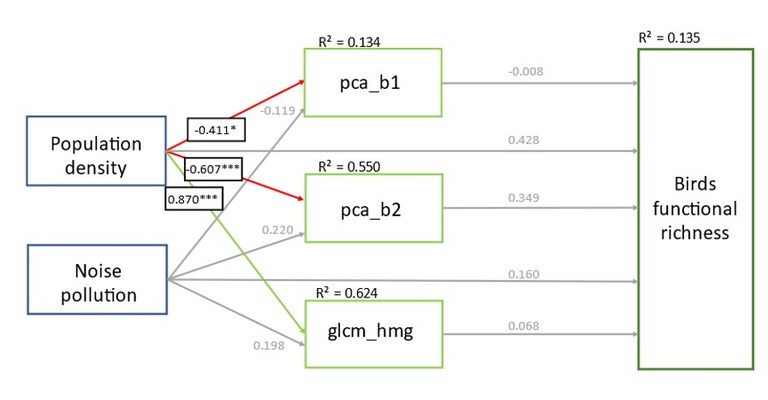Birds in the city: understanding direct and indirect effects of human disturbance and vegetation structure on functional diversity in Berlin
Estelle Solem
Growing urbanization is one of the most important sources of anthropogenic modification of the landscape and, therefore, alters wildlife community composition. With urban areas creating novel ecosystems, we still need to understand how wildlife communities respond to them in term of functional diversity. In this context, birds are good indicators to understand wildlife response to novel ecosystems as they have been thoroughly studied and are easy to monitor.
This study focuses on data from breeding bird species in Berlin (including data from more than 90 bird species), to analyse the relationship between functional diversity, human disturbance variables (population density and noise) and vegetation structure in an urbanization gradient, at two different spatial scales (monitoring quadrant and bird territory).
The breeding bird community was sampled in 29 1x1km quadrants across the study area, including the exact location of the territories within the quadrants. We computed three functional diversity indices representing different facets of functional diversity: functional richness (FRic), functional evenness (Feve) and functional divergence (Fdiv). We characterised the urbanization gradient based on human disturbance variables (noise pollution, human population density) and vegetation structure indices, based on a high-resolution RapidEye image of Berlin. We first explored the bird community’s response to the environmental variables using a Principal Coordinate Analysis (PCoA). We then ran structural equation models (SEMs) to determine the indirect and direct effects of the environmental variables on the three functional measures and the two scales of study, a fine detailed scale (territory level) and a coarser scale (quadrant level).
The PcoA revealed the clustering of a high number of quadrants along an urban gradient characterised by the following environmental drivers: imperviousness, noise, and light pollution, PCA band 1 and 2 (Figure 1). In the case of human density population, this variable pertained to this gradient at the finer scale but had an opposite effect at the coarser scale. Looking at both environmental and trait associations in the plots, we determined that sites were located within a gradient describing higher to lower degree of urbanisation.
The SEMs highlighted that the observed relation between the functional diversity measures and the environmental predictors depended on the spatial scale: at the quadrant level, there was no effect on functional richness (Figure 2), functional evenness increased with noise pollution and functional divergence decreased with human population density, whereas at the territory level, functional richness was positively related to noise pollution, functional evenness increased with noise pollution but decreased with human population density and functional divergence increased with noise pollution.
We found that the effects of human disturbance variables on bird functional diversity were scale-dependent, with human population density displaying a greater impact at the coarser scale while noise pollution effects were mainly detected at the finer scale. Furthermore, we provided evidence that anthropogenic variables were the most significant predictors of functional diversity with their effects being both direct and mediated by the vegetation structure. In line with previous studies we found that human population density was a driver of loss of functional diversity. On the contrary, noise pollution was surprisingly related to an increase of functional diversity, which can be explained by the unique conditions created in cities around noise areas that are typically free from human activity. Our study supports that working at different spatial scales is primordial to fully understand the bird community response to urbanization.

Fig. 1: PCoA at the quadrant level. The grey arrows are the environmental variables, the green arrows the single traits and the red arrows the breeding bird species.

Fig. 2: SEM path for functional richness at the quadrant level. Grey arrows are statistically irrelevant paths, green arrows describe statistically relevant positive effects, and red arrows statistically relevant negative effects. Given are the standardized path coefficients and their respective statistical significance (*p < .05, **p < .01, ***p < .001) and the marginal coefficients of determination for each response variable (R2). Sample size corresponds to n 29 plots.
